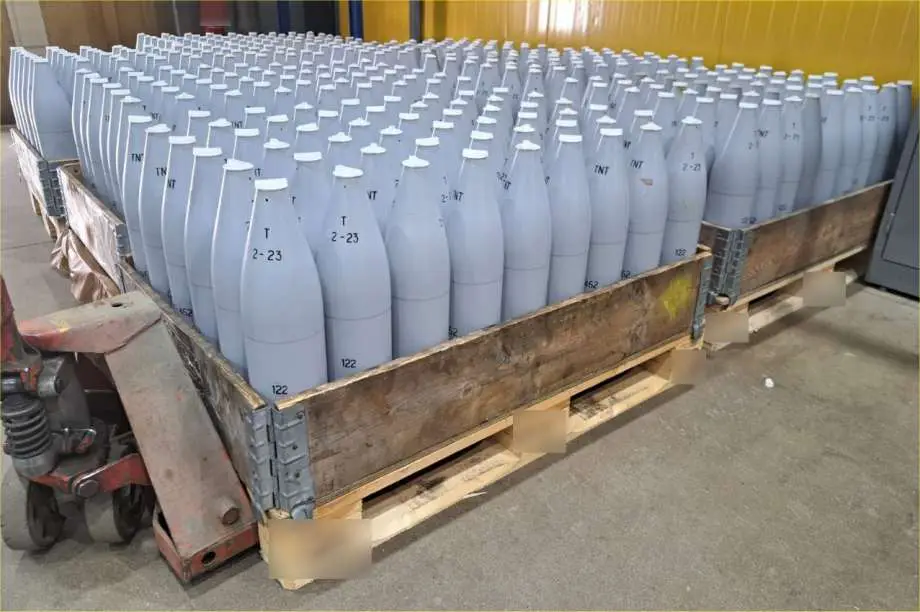Breaking news
Ukrainian company Bronetehnika delivers first batch of 122mm shells to the army.
On August 25, 2023, Ukrainian company Bronetehnika LLC delivered the first batch of 1,000 122mm fragmentation artillery shells to the army. These shells were produced in collaboration with an Eastern European ammunition holding. The 122mm shells, called "Air," are designed to be compatible with the Russian-made D-30 and 2S1 artillery systems.
Follow Army Recognition on Google News at this link

122mm shells delivered to the Ukrainian army (Picture source: Bronetehnika LLC )
Producing ammunition for these artillery systems has been a recurring challenge in Ukraine, as the daily rate of shells fired by both sides remains substantial. The need to continually supply artillery is pressing. While many 155mm shells are produced by Western countries, there is not a significant production in Russian 122mm caliber. The news of the production and delivery of 122mm shells is therefore good for the Ukrainian forces, as they possess a large number of artillery pieces in Russian, and not NATO, calibers like 122mm. Two of these are the D-30 and the 2S1.
The D-30 is a 122mm towed howitzer designed in the Soviet Union in the 1950s. With a combat weight of 3,210 kg and a transport length of 5.4 meters, this howitzer was designed to be both powerful and relatively mobile. Its barrel measures 4.66 meters long, equivalent to 38 calibers, and it is equipped with a semi-automatic vertical sliding-wedge breech system. The recoil system is hydro-pneumatic, allowing for better recoil absorption during firing.
The standard crew for operating the D-30 consists of a team leader and seven other members. The system uses 122 x 447 mm shells, with separate loading charges and projectiles. The D-30 is capable of an elevation range from -7 to 70 degrees and a full 360-degree rotation. In terms of rate of fire, it can achieve a maximum of 10 to 12 rounds per minute and maintain a sustained rate of 5 to 6 rounds per minute. Its effective firing range is 15.4 km, extendable to 21.9 km with rocket-assisted projectiles.
The 2S1 is a self-propelled artillery system designed in the Soviet Union between 1956 and 1961. Entering service in 1972, more than 10,000 units were produced until 1991. Weighing 16 tonnes and measuring 7.26 meters long, the 2S1 is equipped with a 122mm cannon with a barrel length of 4.27 meters. The vehicle is powered by a YaMZ-238N diesel engine with 220 kW (300 hp) and uses a torsion bar suspension.
The standard crew for the 2S1 is four people. The system uses 122 x 447 mm shells with separate loading charges and projectiles. The breech mechanism is a horizontal sliding-wedge, semi-automatic. The 2S1 is capable of an elevation range from -3 to +70 degrees and a full 360-degree rotation. Its maximum rate of fire is 5 rounds per minute, with a sustained rate of 1 to 2 rounds per minute. The initial projectile velocity is 680 m/s, and its maximum firing range is 15.3 km, extendable to 21.9 km with special projectiles.
In terms of mobility, the 2S1 can reach a maximum speed of 60 km/h on the road and 30 km/h off-road. It also has the ability to swim at a speed of 4.5 km/h and has an operational range of 500 km. The vehicle's armor varies between 7 and 20 mm, providing basic protection to the crew.
Both artillery systems are intended for use against enemy fortifications, defensive lines, and armored vehicles. The company emphasizes that the safety of artillery personnel using these shells is crucial for the success of counter-offensive operations. Bronetehnika LLC has re-established partnerships and integrated components from several European countries to continue supplying these artillery shells to Ukrainian defense forces.


























